Breakfast: The when, what and how much!
The standard workout breakfast
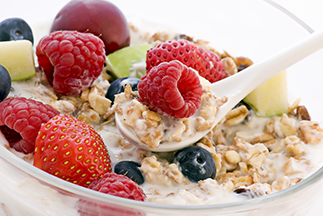 If weight loss isn’t your goal, start your day as usual. Have a balanced breakfast (include each main food group, plenty of whole grains and cereals and some fruit) no later than one hour before your workout. Failing this, you could have a banana (or another fruit or low-GI option) or a protein bar, plus a fruit juice 20-30 minutes prior. Just make sure you leave 20 minutes for your tummy to empty before you start exercising.
If weight loss isn’t your goal, start your day as usual. Have a balanced breakfast (include each main food group, plenty of whole grains and cereals and some fruit) no later than one hour before your workout. Failing this, you could have a banana (or another fruit or low-GI option) or a protein bar, plus a fruit juice 20-30 minutes prior. Just make sure you leave 20 minutes for your tummy to empty before you start exercising.
Additionally, you should take a water bottle with diluted fruit juice to sip during workouts - if this isn’t possible just take water. But bear in mind that diluted fruit juice is a great natural replenishment drink.
The fat-burning breakfast
If you’re aiming to shed some body fat, your start to the day will be a little different. Ideally, you should do your morning fat-burners before breakfast. Not only is your metabolic rate at its highest, but the body seems to use fuels better in the cold. Furthermore, by not providing the body with easy fuels (carbohydrates) you will burn fat instead.
If you feel lightheaded during a workout, take a diluted juice drink along with you to sip in between sips of water, or have a banana before you go. Remember to always take water! If you have any difficulties with exercise, always seek medical advice before continuing.
Lastly, don’t be tempted to skip your breakfast afterwards. Your body will work best for you if you look after it. You must have a healthy and balanced breakfast within 20-30 minutes after your workout to allow your body to recover and to improve its ability to use energy stored in your body.
Keep up with your activity; fit people burn fat more efficiently so not only will you naturally use up stored fat, but you will get fitter.
Myths and Facts
Skipping breakfast slows weight loss
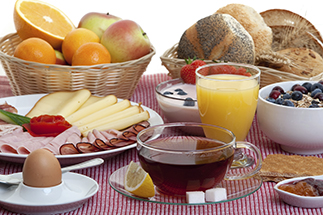 TRUE: Research shows that if you eat breakfast you’re more likely to lose weight and keep it off than if you skip breakfast. Breakfast eaters don’t appear to consume more kilojoules, and those who don’t skip this important meal are more inclined to exercise. It’s also likely that eating breakfast reduces inappropriate food choices, which tend to happen when we are hungry. So, as you can see, as well as being a good nutritional start to the day for improved energy, a healthy breakfast is a must.
TRUE: Research shows that if you eat breakfast you’re more likely to lose weight and keep it off than if you skip breakfast. Breakfast eaters don’t appear to consume more kilojoules, and those who don’t skip this important meal are more inclined to exercise. It’s also likely that eating breakfast reduces inappropriate food choices, which tend to happen when we are hungry. So, as you can see, as well as being a good nutritional start to the day for improved energy, a healthy breakfast is a must.
Exercising in the morning is the best time for burning fat
TRUE: This is true as your metabolic rate is highest in the morning; however, it is not always convenient for everyone to train then – the main point is to exercise regularly!
Excess sugar turns to fat
FALSE: Strictly speaking, this does not happen easily in the body. In fact, too much sugar from food or alcohol prevents you from using stored fuel (fat). Sugar is the body’s preferred form of fuel, so providing it with lots reduces your chances of using fat stores. You should balance out your carbohydrates, eat whole grains, adequate fibre and protein at each meal to feel full for longer.
You should food combine (avoiding carbs before lunch and not eating them with protein)
FALSE: Our bodies need an intake of all nutrients throughout the 24-hour period; consequently, we should consume a healthy balance of as many nutrients as possible during each meal.
Protein-containing foods make you feel full
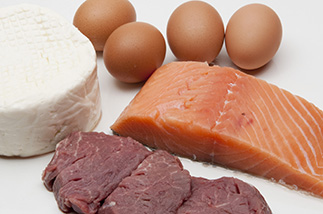 TRUE: In fact, protein is known as the satiety nutrient. Simply, this means it is the food that tells you that you are full and to stop eating. Carbs have a weak satiety effect, and alcohol and fat very little, if any at all. That’s one reason why including protein in your meals is so important.
TRUE: In fact, protein is known as the satiety nutrient. Simply, this means it is the food that tells you that you are full and to stop eating. Carbs have a weak satiety effect, and alcohol and fat very little, if any at all. That’s one reason why including protein in your meals is so important.
7 simple things you can do to improve your diet
1. Ensure you eat a variety of foods
Eating a wide variety of foods will increase the nutrients you gain from your diet and decrease the percentage of ‘inappropriate’ foods.
Do you:
- Eat different coloured fruit and vegetables each day?
- Eat wholegrain breads and cereals?
- Try new recipes?
- Eat out at a variety of restaurant types?
2. Reduce your saturated fats
Current dietary recommendations advise moderation in total fat intake (20-35% of total kilojoules), with less than 10% of kilojoules from saturated fatty acids, and intake of trans-fatty acids as low as possible. When selecting milk or milk products,
low-fat or fat-free choices are recommended.
Do you:
- Use 100% virgin cold-pressed olive oil?
- Trim your meats before cooking?
- Limit your intake of takeaways to treats?
- Remove the skin from chicken?
- Use yoghurt instead of sour cream?
- Use vegetable-based or low-fat spreads?
- Avoid sauces and creamy meals?
- Limit the number of fatty foods in a meal?
- Use low-fat ice-cream?
- Use low-fat dairy products or reduce intake?
3. Increase the fresh foods in your day
An easy way to increase the quality and quantity of nutrients in your diet is to consume more fresh foods. You should replace processed foods with fresh alternatives. Fresh produce is higher in vitamins, minerals and antioxidants. Research also supports the many health benefits from raw plant foods that we are still not able to synthesise in the laboratory.
Do you:
- Include fresh vegetables in all dinners?
- Limit or avoid frozen meals?
- Limit your reliance on canned foods?
4. Eat whole food varieties
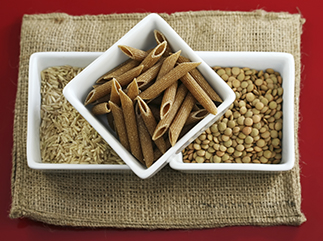 Choose breads, cereals and meals with whole grains, seeds, nuts etc. over refined varieties.
Choose breads, cereals and meals with whole grains, seeds, nuts etc. over refined varieties.
Do you:
- Choose wholegrain breads?
- Use brown rice when possible?
- Drink soy made from ‘whole soy beans’?
- Eat high-fibre cereals made from grains?
- Use yoghurts that are made naturally and have no added sugar?
5. Balance out the large nutrients
Balancing out the proportions of carbohydrate, protein and fat as well as actual meal size is important for satiety (feeling full) and health.
Do you:
- Ensure that you include roughly a palm-size serving of protein on a plate? This should represent ⅓ of your proportion of food for the meal (unless otherwise required)
The Food Based Dietary Guidelines are as follows:
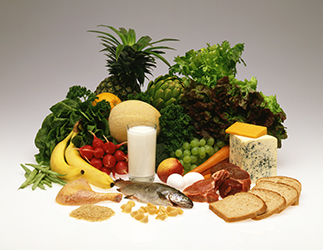 1. Enjoy a variety of foods
1. Enjoy a variety of foods
2. Be active
3. Drink lots of safe, clean water
4. Make starchy foods the basis of most meals
5. Eat plenty of fruits and vegetables every day
6. Eat dry beans, peas, lentils and soya regularly
7. Chicken, fish, meat, milk or eggs can be eaten daily
8. Eat fats sparingly
9. Use salt sparingly
10. Use food and drinks containing sugar sparingly and not between meals
11. If you drink alcohol, drink sensibly

